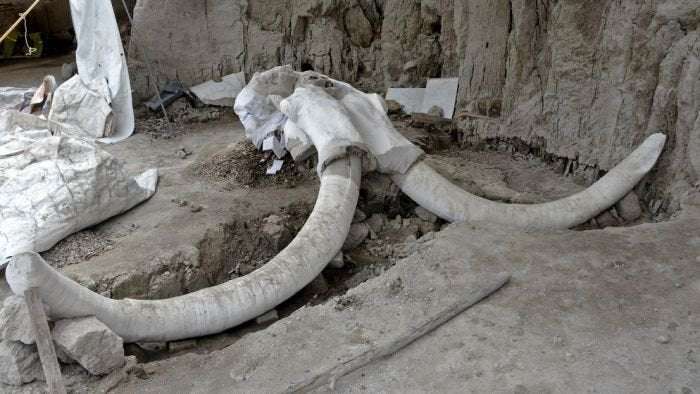Mammoth skeletons and 15,000-year-old human-built traps found in Mexico
Archaeologists have said they have made the largest discovery of mammoth remains, with a trove of 800 bones from at least 14 of the extinct giants found in central Mexico.
Key points: Evidence of mammoth traps were found during excavations on land that was to be used as a garbage dump
The pits were about 1.7 metres deep and 25 metres in diameter
Researchers said at least five mammoth herds lived in the area of the find
They also found two human-built pits dug 15,000 years ago to trap mammoth, believed to have been the first find of mammoth traps set by humans.
Researchers from Mexico's National Institute of Anthropology and History said on Wednesday (local time) the pits were found during excavations on land that was to be used as a garbage dump.
The pits were about 1.7 metres deep and 25 metres in diameter.
The institute said hunters may have chased mammoths into the traps. Remains of two other species that disappeared in the Americas — a horse and a camel — were also found.
"This is the largest find of its kind ever made," the institute said in a statement.
The skeletal remains were found in Tultepec, near the site where President Andres Manuel Lopez Obrador's Government is building a new airport for Mexico City.
Some of the remains bore signs that the animals had been hunted, leading experts to conclude that they had found "the world's first mammoth trap", the statement said.
"Mammoths lived here for thousands of years. The herds grew, reproduced, died, were hunted …they lived alongside other species, including horses and camels," archaeologist Luis Cordoba told journalists.
Researchers said at least five mammoth herds lived in the area of the find.
Mexico has been the scene of surprising mammoth discoveries before.
In the 1970s, workers building the Mexico City subway found a mammoth skeleton while digging on the capital's north side.
It was unclear if plans for the garbage dump would proceed.
Topics: archaeology, dna, genetics, science-and-technology, animal-science, animals, mexico

SecTrono on November 7th, 2019 at 13:40 UTC »
it must have been so strange for the mammoths. for thousands of years no one would fuck with them. they were nearly untouchable because they were so huge so they could more or less do whatever they wanted. maybe a hungry saber tooth tiger might be crazy enough to try and take one down but only if it was desperate.
then out of nowhere these scrawny little apes pop up. they aren't much to look at but they are much smarter than the mammoths and start coming up with all these crazy plans that actually allow them to take a mammoth down.
it would be like if the squirrels suddenly became more intelligent than us and starting figuring out ways to take us out.
RedSkyNight on November 7th, 2019 at 13:38 UTC »
This is really interesting. They also found remains of horse and CAMEL in the pit. There is no mention of tools being found but there are signs of butchery.
ynotone on November 7th, 2019 at 07:57 UTC »
Yeah? Or are they human traps built by the mammoths? Hmm..